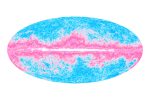
© 2021 Jonathan Feldschuh
A full spectrum of vivid, blowtorched colors blasts out from several of Jonathan Feldschuh’s new paintings. Others are more muted in hue but no less multicolored or rich. Still others have the respite of a deep blue-black ground. All, however, radiate an intergalactic glow as if seen through an immense mediating lens probing the furthest reaches of immeasurable space. They might be details of the elegant universe in either macro- or micro-mode or they might be non-representational paintings. Feldschuh, like many artists today, likes it at least both ways, collapsing the syntax of representation into that of abstraction. Nonetheless, for this series, his (con)figurations are based on actual images, taken from simulations created by supercomputers or in wind tunnels and other test sites. Feldschuh says he is interested in less familiar scientific imagery and in phenomena that can’t be observed directly.
His subjects in this exhibition are simulations of exploding supernovas and the wave in the wake of a jet at supersonic speed, drop formations and an image of the universe that is not the universe. The supernova pictures, taken from stills which he depicts in searing oranges, greens, reds and yellows, also suggest more figurative interpretations, like an extra-terrestrial creature in a sci-fi film or a Symbolist eyeball by Odilon Redon. They also remind me of the often ingenious connections that older belief systems established between different orders of things that resembled each other, so that the pattern of a flower, for instance, mirrored that of the universe. The freeze-framed drop images, which Feldschuh refers to as “uneasy icons,” illustrate the principles of fluid dynamics. On the one hand, they belong to the innocuous category of things poured; on the other, he envisions them as something syrupy, like Coca-Cola with its socio-political implications or phenomena that are more corrosive, contaminated, nuclear, a toxicity reinforced by his palette of deep purpled browns against a scorched yellow ground. Cold, Dark (the only titled painting as of this writing) is a whirling open disc of pinks, corals, yellows, turquoises, against a black field, the universe as a ring of neon lights, Miami in space, say, surrounded by massive, mysterious cold dark matter. Whatever else they are, these paintings are artificial constructs, heraldic and symmetrical in composition, their frontality confrontational, even ominous. For all their balance, they are unstable in sensation, as if they are about to shift into another state, go into meltdown, vanish.
Feldschuh, surprisingly, prefers paint to new media, conjuring up his theory of everything with acrylic paints and resin applied to large—but not overwhelmingly so—wood panels covered with canvas. Feldschuh’s color scheme is not that of the scientists who tend to choose standardized spectra in their interpolation of numerical data into images. They are more interested in information than aesthetics, although the supersaturated colors they use can be breathtaking. Their colors are arbitrary, Feldschuh reminds us, and he exercises his own freedom to choose whatever color he wants as an artist in thrall to the dictates of his painting. He likes the process because it is a further re-creation and representation, a metaphor for what painting is about. Close-up, many of his paint strokes seem flash-frozen, comic-book quotations of paint strokes, a reference to the fantastic world of anime, perhaps, or more essentially, to art as art. In other details, the paint is beautifully mottled, moiréd, swirled, the result of painting wet into wet. Feldschuh uses squeeze bottles as his primary tool, although he also tilts his paintings to permit run, a kind of spontaneous, free-form drawing with a certain, but not absolute, control, like the real/unreal phenomena he riffs on. He then goes in delicately with color pencil to tweak his results, part of the labor-intensive aesthetic of the moment in which process bridges the gap between the real and the mediated, the appropriated and the original, art and life. .

© 2021 Jonathan Feldschuh